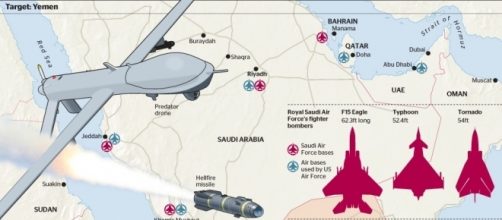The week after Ryan Owens of SEAL team 6 was killed in Yemen, the then National Security advisor Michael Flynn put Iran on notice as a public provocation for committing hostile acts against U.S. allies Saudi Arabia, through Houthis rebels, as reported by Blasting News.
Since the incident, another operation was completed in Yemen last Thursday and Friday with more than 30 airstrikes against suspected al-Qaeda targets, according to Pentagon spokesman Capt. Jeff Davis. Davis said there hadn't been any firefights or U.S. ground troops during the raid since the January operation.
SEAL Ryan Owens added to list of casualties
In his statement to reporters, Capt. Davis was adamant about conducting airstrikes on al-Qaeda in Yemen in order to "protect American lives." But the mission with Ryan Owens conducted in January did not only take two American lives, it reportedly also killed more civilians than terrorists. The final report made public on the raid said that 57 people were killed, 16 of which were civilians and the rest, "terrorists" according to Saudi Media.
US launches first military action in Yemen since Navy SEAL Ryan Owens killed https://t.co/G0n3uk7M0x by @LucasFoxNews
— Fox News (@FoxNews) March 2, 2017
Many considered the raid a blunder due to the death of the Navy Seal Owens, a six-year-old girl, and the loss of a $75 million dollar military aircraft which even the Trump administration would not accept blame for after attempting to defend it as a successful mission.
President Trump would later isolate the responsibility of the Yemen raid to the generals who carried it out. This is further validated by the fact that in a hearing on Thursday, CENTCOM commander Gen. Joseph Votel took responsibility for the losses.
Casualties of Yemen raids
Gen. Votel even acknowledged during the hearing that there were civilian casualties, aside from those carrying out the raid who were wounded.
In 2014, the U.S. conducted another Yemen raid against the same group to save freelance photojournalist for Yemen Times Luke Somers under the Obama administration. It was actually the second attempt to rescue him since being kidnapped in Sana. But he was seriously wounded during that raid and later died from his wounds along with another hostage, South African teacher Pierre Korkie.
Many families have reacted strongly to these losses. Reports of the most recent raid state that all of those killed were militants, the AFP was told eight al-Qaeda militants to be exact, which included a commander named Saad Atef. The details of the raid come from tribal sources in Shabwa, Abyan and al-Bayda provinces, an area that The Pentagon confirmed they conducted airstrikes in. But, those sources also say that U.S. ground troops engaged in a few firefights with militants despite Gen. Jeff Davis saying it was not true.
The aftermath
Military officers aren’t happy with Trump’s tribute to fallen Navy SEAL Ryan Owens https://t.co/XRA6FmcAil pic.twitter.com/CC23oLbeQ2
— BuzzFeed News (@BuzzFeedNews) March 1, 2017
One report by Al Jazeera says that local residents in provinces reported two gun battles between U.S.
troops and al-Qaeda, which the Pentagon has denied. Even with a hint of casualties, however, the overall view from even the "botched" raid in January is that it was successful since the military was able to gather intelligence nonetheless. What's left is the reaction for the death of Ryan Owens in the form of political criticism and anger from his father, who reportedly refused to meet with President Trump when he went to pay his respects at his son's funeral.
In a more symbolic gesture during President Trump's first address to Congress in February, he invited Ryan Owens' widow to the speech who received a standing ovation from both Republicans and Democrats. To go with the criticism, Trump's address is said to be the first time since his inauguration that he appeared "presidential" and less controversial. By paying respects in public during the address to the fallen Navy SEAL, it would serve to improve the president's reputation in the space of public opinion.

